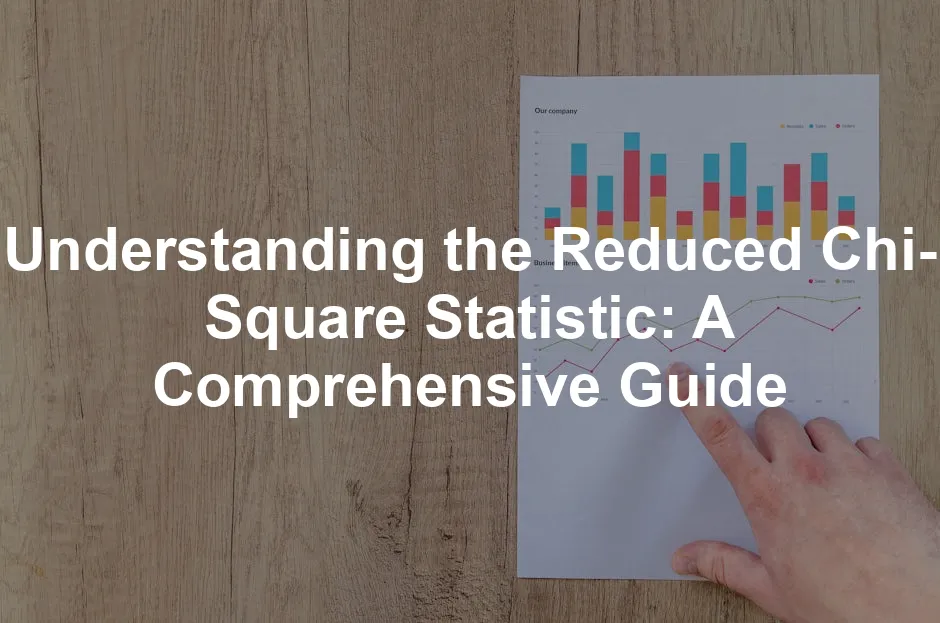Introduction
The reduced chi-square statistic is a vital tool in the realm of statistical analysis. It helps researchers assess how well a statistical model fits their data. But what exactly is this metric, and why should you care? Think of it as a quality control measure for your statistical models. If a model fits well, the reduced chi-square value should hover around 1. If it strays far from this value, it might signal a misfit or an issue with your data.
You’ll encounter the reduced chi-square statistic in various fields, including astronomy, where it gauges the accuracy of models predicting celestial phenomena. In geochronology, it provides insights into isotopic dating, helping scientists determine the age of geological formations. Regression analysis also benefits from this statistic, enhancing our understanding of relationships between variables.
Understanding the reduced chi-square statistic is essential for model assessment and goodness-of-fit testing. A high or low value may prompt you to revisit your model or data, leading to better conclusions. In essence, mastering this statistic can elevate your statistical prowess, ensuring more reliable and valid results in your research.

What is the Reduced Chi-Square Statistic?
Definition of Reduced Chi-Square
The reduced chi-square statistic, denoted as \(\chi_{\nu}^{2}\), is mathematically defined as:
\(\chi_{\nu}^{2} = \frac{\chi^{2}}{\nu}\)
Here, \(\chi^{2}\) represents the chi-square statistic, while \(\nu\) is the degrees of freedom. But what do these terms mean? The chi-square statistic itself is a weighted sum of squared deviations, calculated as:
\(\chi^{2} = \sum_{i} \frac{(O_{i} – C_{i})^{2}}{\sigma_{i}^{2}}\)
In this equation, O represents observed values, C signifies calculated or expected values, and \(\sigma_{i}^{2}\) denotes the variance of the observations. The degrees of freedom, \(\nu\), is determined by the number of observations minus the number of parameters fitted:
\(\nu = n – m\)
Where n is the total number of observations, and m is the number of fitted parameters. This division by degrees of freedom allows the reduced chi-square to provide a normalized measure of fit quality, making it easier to assess whether a model is underfitting or overfitting the data.

Derivation of the Formula
Let’s break down the reduced chi-square formula. The chi-square statistic, \(\chi^{2}\), accumulates the discrepancies between observed and expected values across all data points. When we divide this sum by the degrees of freedom, we get a more meaningful representation of fit quality. Essentially, this normalization helps to account for the number of data points relative to the complexity of the model being tested.
Each component serves a distinct purpose. The chi-square statistic captures the total squared deviations, while the degrees of freedom adjusts for the number of parameters involved in the model. A correctly derived reduced chi-square value empowers researchers to gauge the fit without being skewed by the number of data points or model complexity.
Key Concepts
Understanding the reduced chi-square statistic involves familiarizing yourself with several related concepts. Degrees of freedom play a crucial role here, as they adjust the statistic based on the number of constraints placed on the model. Variance is another key term, reflecting how much measurements deviate from the mean. This variability can impact the reduced chi-square value, particularly when assessing model fits.
Additionally, weighted least squares is a critical concept linked to the reduced chi-square statistic. It emphasizes the importance of assigning weights to data points based on their variability. This technique ensures that more reliable observations have a greater influence on the fit, leading to a more accurate representation of the underlying relationship in the data. Understanding these concepts will enhance your ability to utilize the reduced chi-square statistic effectively in various applications.

If you’re looking to deepen your understanding of statistical methods, consider checking out Statistical Analysis: A Practical Guide for Researchers. This book is a treasure trove of insights that can elevate your research game!
Interpretation of the Reduced Chi-Square Value
Goodness of Fit Assessment
The reduced chi-square value, denoted as \(\chi_{\nu}^{2}\), is a normalized measure of goodness of fit. When interpreting this value, certain thresholds come into play:
– \(\chi_{\nu}^{2} \gg 1\): This indicates a poor fit. The model fails to capture the data’s underlying structure. If your chi-square is significantly greater than 1, it suggests that the model is not adequate for the dataset. You might be underestimating the variability in your data or failing to account for important factors.
– 1 \approx \chi_{\nu}^{2} < 1: Here lies the sweet spot. Values close to 1 suggest a good fit, meaning the model represents the data well. However, if the value dips below 1, it may indicate overfitting. In this scenario, the model captures random noise rather than the actual trend. Overfitting can lead to poor predictive performance when applied to new data.
These interpretations have significant implications for model validity. If your fit is poor, it may warrant reconsideration of model parameters or even a different modeling approach. Conversely, a good fit (around 1) can boost confidence in your findings but remains a cue to monitor for overfitting.
Confidence Intervals and Statistical Significance
Linking the reduced chi-square to confidence intervals enhances your understanding of model parameters. Confidence intervals provide a range within which we expect the true parameter values to fall, given the variability in the data.
To calculate confidence intervals based on the reduced chi-square, you typically follow these steps:
1. Determine the estimated model parameters and their respective uncertainties.
2. Use the reduced chi-square value to adjust the standard errors of the parameters. This adjustment helps account for the fit quality.
For instance, if you have a reduced chi-square value of 1.2, it suggests a slight overestimation of uncertainty. You could adjust your standard errors by multiplying them by the square root of the reduced chi-square. This adjustment gives a more accurate representation of the uncertainty associated with each parameter estimate.
Imagine you’re analyzing a dataset that involves predicting sales based on advertising spend. After fitting your model, you find a reduced chi-square of 1.1. You take this value and adjust your confidence intervals accordingly. This adjustment results in tighter intervals, reflecting the model’s reliability.

To further enhance your data analysis skills, you might consider Python for Data Analysis: Data Wrangling with Pandas, NumPy, and IPython. This book is perfect for those who want to dive into data manipulation and analysis!
Common Misinterpretations
Several misconceptions often arise regarding the reduced chi-square statistic. One prevalent myth is that a reduced chi-square value of zero indicates a perfect fit. In reality, achieving a zero value is not only unrealistic but also impossible in practical applications. A perfectly fitting model would imply that there is no variability in the data, which contradicts the nature of most datasets.
Another crucial point to consider is the impact of noise and variability in data. Noise, the random fluctuations that occur in measurements, can skew the reduced chi-square value. For instance, in small datasets, random noise can significantly influence the statistic, leading to misleading conclusions. Thus, it’s essential to understand that a lower reduced chi-square value doesn’t always equate to a better fit, especially if derived from limited data.
Ultimately, grasping the nuances of the reduced chi-square statistic empowers researchers to make informed decisions regarding their models. By avoiding common pitfalls and accurately interpreting the statistic, you can enhance the credibility and reliability of your statistical analyses.

Applications of the Reduced Chi-Square Statistic
Geochronology
In the field of geochronology, the reduced chi-square statistic plays a crucial role in isotopic dating. It helps researchers assess the fit between observed data and model predictions. This assessment becomes particularly important when determining the age of geological formations.
One key concept in this context is the Mean Squared Weighted Deviation (MSWD). The MSWD evaluates the goodness of fit while considering both internal and external reproducibility of isotopic measurements.
Interpreting MSWD values can be quite telling:
– MSWD = 1: This indicates that the age data fits a univariate normal distribution perfectly. The model captures the variability in the data without overestimating uncertainties.
– MSWD < 1: If the MSWD value is less than one, it suggests that the observed scatter is less than predicted. This often points to overestimated analytical uncertainties, meaning the model might be too conservative.
– MSWD > 1: A value greater than one implies that the observed scatter exceeds predictions. This can indicate overdispersion, urging researchers to revisit their understanding of the isotope system used.
Given the complexities of geochronological data, using a weighted mean is often preferred. This method accounts for the varying significance of each measurement, providing a more robust estimate of the age. By calculating the weighted variance, scientists can achieve a more accurate measure when individual determinations differ significantly.
For those interested in a comprehensive understanding of data science, check out Data Science for Business: What You Need to Know about Data Mining and Data-Analytic Thinking. This book provides practical insights that are invaluable for anyone navigating the data landscape.
Rasch Analysis
Rasch analysis employs the reduced chi-square statistic for evaluating the fit of data to the Rasch model. This model is widely used in educational testing and psychometrics to assess the validity of measurement scales.
In this analysis, two specific metrics come into play: the outfit mean-square statistic and the infit mean-square statistic.
– Outfit Mean-Square: This statistic evaluates how well items fit the model, considering unexpected responses. High values here may indicate that certain items are not functioning as intended.
– Infit Mean-Square: In contrast, this statistic focuses on unexpected variations among responses that are closer to the expected value. This is crucial for understanding how individual responses relate to the model.
Both statistics help in identifying misfitting items, guiding researchers in refining their measurement tools. By leveraging the reduced chi-square statistic in Rasch analysis, researchers can enhance the reliability and validity of their assessments.

Astrophysics and Nonlinear Models
The reduced chi-square statistic finds its way into astrophysics as well, particularly when analyzing data from celestial observations. However, its application comes with limitations, especially in nonlinear models.
Nonlinear models often present challenges in estimating degrees of freedom, making the reduced chi-square statistic less reliable. For instance, when fitting a nonlinear model to astrophysical data, the complexity of the model can obscure the interpretation of the reduced chi-square value.
Despite these limitations, the statistic is still utilized in various astrophysical analyses, such as determining the characteristics of celestial bodies or analyzing light curves from distant stars. Researchers must remain cautious, though, as the value of reduced chi-square can be influenced by random noise in the data.
Recognizing these constraints is essential. For example, small datasets are particularly susceptible to noise, which can skew the reduced chi-square value. Thus, while it can provide valuable insights, it should be complemented with other statistical methods for a comprehensive analysis.

To support your research endeavors, consider investing in a Scientific Calculator. It’s a handy tool for performing complex calculations with ease!
Best Practices for Using the Reduced Chi-Square Statistic
Avoiding Common Pitfalls
Using the reduced chi-square statistic effectively requires understanding its nuances and adhering to best practices.
First and foremost, proper weighting in model fitting is vital. If the weights assigned to data points are incorrect, the reduced chi-square value may misrepresent the model’s fit. For instance, using overly large weights can lead to a value significantly smaller than 1, suggesting an unrealistically good fit.
Moreover, researchers should be wary of small datasets. The reduced chi-square statistic can be heavily influenced by noise in these cases. A small dataset may lead to misleading conclusions, so it’s essential to consider larger sample sizes whenever possible.

If you’re in need of a great notebook for all your calculations and notes, check out this Professional Notebook for Researchers and Scientists. It’s perfect for jotting down your brilliant ideas!
Recommendations for Model Assessment
When interpreting reduced chi-square results, it’s crucial to establish clear guidelines. Values around 1 indicate a good fit, while those significantly higher or lower signal issues with the model. It’s wise to establish confidence intervals for your parameters based on the reduced chi-square value. This provides a clearer picture of uncertainty in your estimates.
Additionally, consider using alternative metrics for assessing model fit alongside the reduced chi-square. Metrics such as Akaike Information Criterion (AIC) or Bayesian Information Criterion (BIC) can offer complementary insights, guiding researchers towards more robust conclusions.
By applying these best practices, researchers can maximize the utility of the reduced chi-square statistic, leading to better model assessments and more reliable outcomes in their analyses.

Avoiding Common Pitfalls
When using the reduced chi-square statistic, proper weighting is crucial. Incorrect weights can distort your findings. For instance, if you overemphasize less reliable data points, your reduced chi-square value might suggest a model that fits well. In reality, it could be misleading. Always verify your weights align with the variability in your data.
Additionally, small datasets can significantly impact the reliability of reduced chi-square values. With fewer data points, random noise can skew results. A low reduced chi-square might look appealing but could stem from insufficient data. Always consider the size of your dataset when interpreting these statistics. Small datasets often lead to unreliable conclusions, so aim for larger samples whenever possible.
Recommendations for Model Assessment
Interpreting reduced chi-square results requires clear guidelines. A value around 1 typically indicates a good fit. However, values much higher or lower signal potential issues. Familiarize yourself with acceptable ranges for your specific context. Using confidence intervals can enhance your understanding of parameter estimates. Adjust these intervals based on the reduced chi-square value to reflect the fit quality accurately.
Furthermore, consider alternative metrics alongside the reduced chi-square. The Akaike Information Criterion (AIC) or Bayesian Information Criterion (BIC) can offer additional insights into model performance. These metrics help to paint a fuller picture of model fit, ensuring a robust assessment. By integrating multiple evaluation methods, you can bolster the credibility of your model assessments.

Conclusion
The reduced chi-square statistic is a cornerstone of statistical analysis. It provides a normalized measure of goodness-of-fit, guiding researchers in their quest for reliable models. Whether in geochronology or astrophysics, understanding this statistic is vital for accurate model assessment.
In geochronology, it aids in isotopic dating, helping scientists accurately determine age through the Mean Squared Weighted Deviation (MSWD). In astrophysics, it assists in analyzing celestial observations, ensuring models reflect astronomical phenomena accurately. However, it’s essential to recognize the limitations of the reduced chi-square, particularly in nonlinear models or small datasets.
Researchers should embrace best practices when using this statistic. Proper weighting, larger datasets, and complementary metrics enhance the reliability of analyses. By being mindful of its limitations, you can make informed decisions, leading to more valid conclusions.
In summary, mastering the reduced chi-square statistic enhances your statistical toolkit. It’s not just about achieving a value close to 1; it’s about understanding the nuances that come with it. Equip yourself with this knowledge, and your analyses will reflect greater accuracy and insight, ultimately enriching your research endeavors.

For those looking to improve their writing skills, consider investing in The Chicago Manual of Style. A great reference for anyone who wants to write with clarity and precision!
FAQs
What does a reduced chi-square value close to 1 indicate?
A reduced chi-square value near 1 is a positive sign. It suggests that your model fits the observed data well. In the world of statistics, a value of 1 means the discrepancies between observed and expected values are on point. Imagine you’re at a party. You want to fit in, and a reduced chi-square of 1 means you’re blending in nicely with the crowd. If your value goes above 1, it’s a red flag, indicating poor model fit. Your model might be missing the mark or overestimating the data’s variability. On the flip side, a value less than 1 can spell trouble too. It suggests overfitting, where your model is working overtime to capture every little noise instead of the actual trend. In this case, it’s like trying too hard to impress your friends, but they end up thinking you’re just being extra. So, keep an eye on that reduced chi-square. Aim for closeness to 1 for a good fit, but don’t ignore the warning signs if it strays too far.
How do I calculate the degrees of freedom for a reduced chi-square statistic?
Calculating degrees of freedom (df) for a reduced chi-square statistic is straightforward. The formula is: \(\nu = n – m\) In this equation: \(n\) represents the total number of observations. \(m\) signifies the number of parameters estimated in your model. Let’s say you have a dataset with 50 observations (n = 50), and you used 3 parameters in your model (m = 3). Plugging these values into the formula gives you: \(\nu = 50 – 3 = 47\) Now, you have your degrees of freedom! This calculation is essential when interpreting the reduced chi-square value. It helps to contextualize how well your model represents the data compared to the complexity of the model itself. More parameters generally mean fewer degrees of freedom, which can alter how you interpret the fit.
Can the reduced chi-square statistic be used for nonlinear models?
Using the reduced chi-square statistic for nonlinear models is a bit like trying to fit a square peg into a round hole. It can be tricky. The primary issue lies in calculating the degrees of freedom accurately. For nonlinear models, degrees of freedom can be ambiguous, leading to less reliable results. While the reduced chi-square can provide some insight, it’s essential to approach with caution. Nonlinear models often require more sophisticated assessment methods. You might want to look at alternative goodness-of-fit measures, such as Akaike Information Criterion (AIC) or Bayesian Information Criterion (BIC), which are more suited for nonlinear contexts. In short, the reduced chi-square can be used, but think of it as a backseat driver. It’s there, but you might want to rely on more robust methods for a clearer path ahead.
What should I do if my reduced chi-square value is much smaller than 1?
If your reduced chi-square value is much smaller than 1, it’s time to put on your detective hat. This low value often indicates that your model is overfitting the data. Your model is capturing random noise instead of the actual trends in the data. Here are some troubleshooting steps to consider: 1. Review Your Model: Are you using too many parameters? Simplifying your model can help reduce overfitting. 2. Check Weights: If you’re using weighted data, make sure the weights are appropriate. Too heavy weights can skew results. 3. Increase Sample Size: A larger dataset can provide a better representation of the underlying trends, which helps improve model fit. 4. Explore Alternative Models: Consider trying different modeling approaches that may better capture the underlying data patterns. By taking these steps, you can work towards improving your model fit and bringing that reduced chi-square value closer to the ideal 1.
How can the reduced chi-square statistic assist in comparing different models?
The reduced chi-square statistic is a handy tool for model comparison. When you have multiple models, you can calculate the reduced chi-square for each one. This allows you to assess which model offers the best fit for your data. Here’s how to use it effectively: 1. Calculate Reduced Chi-Square: Compute the statistic for each model you want to compare. 2. Compare Values: A lower reduced chi-square indicates a better fit. If one model has a reduced chi-square of 1.2 and another is at 0.8, the second model is performing better. 3. Consider Degrees of Freedom: Always take the degrees of freedom into account. A model with more parameters might show a better reduced chi-square value, but it could also be overfitting. 4. Use Complementary Metrics: Pair the reduced chi-square with other metrics like AIC or BIC for a more comprehensive view of model performance. By following this approach, you can effectively utilize the reduced chi-square statistic to guide your model selection process and ensure you’re choosing the best option for your data analysis needs.
Please let us know what you think about our content by leaving a comment down below!
Thank you for reading till here 🙂
Understanding the differences between practical significance versus statistical significance is crucial when interpreting statistical models.
And if you ever need to visualize your data better, consider getting a Whiteboard for Visualizing Data. It’s super handy for brainstorming sessions and presentations!
All images from Pexels




